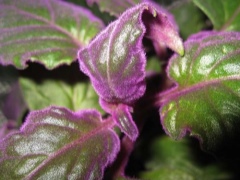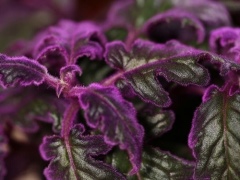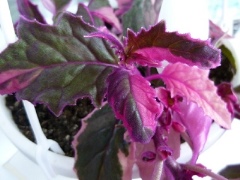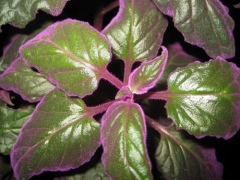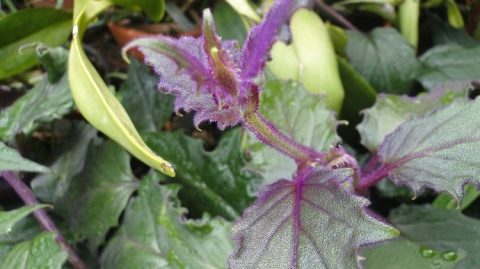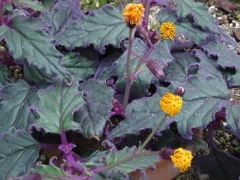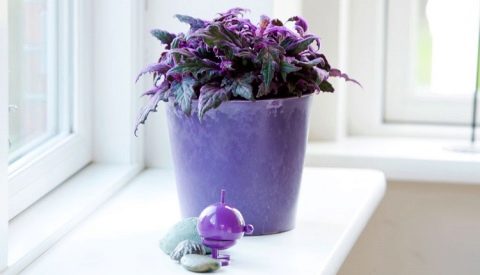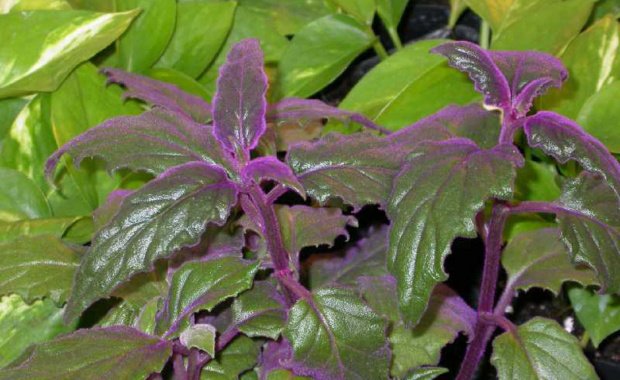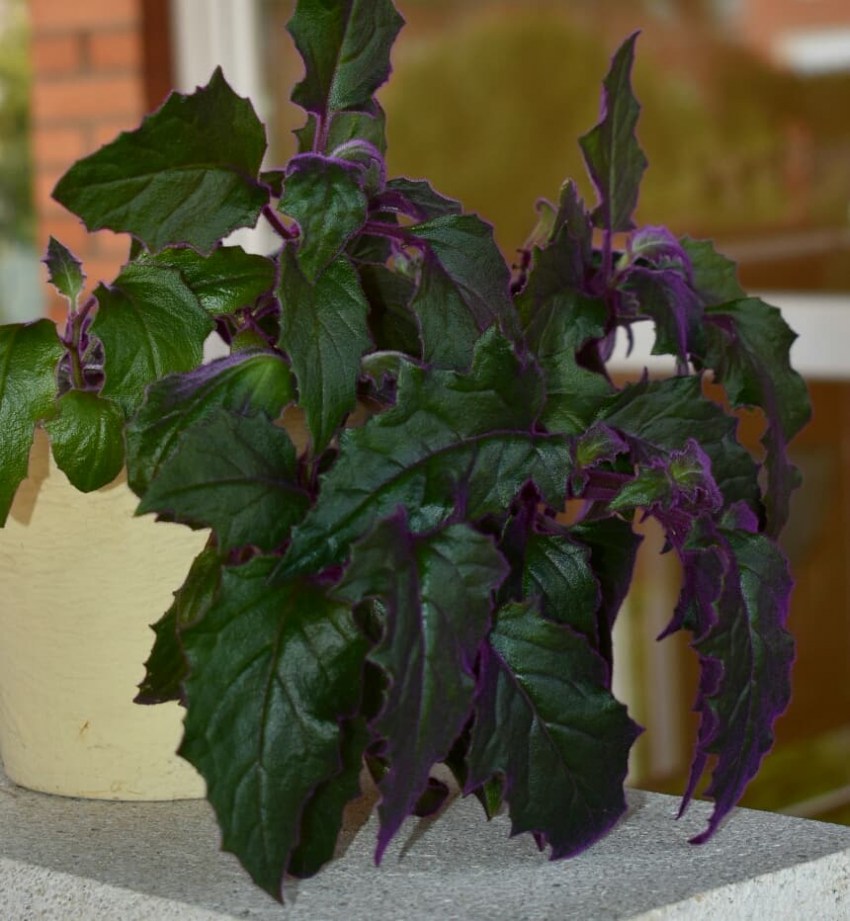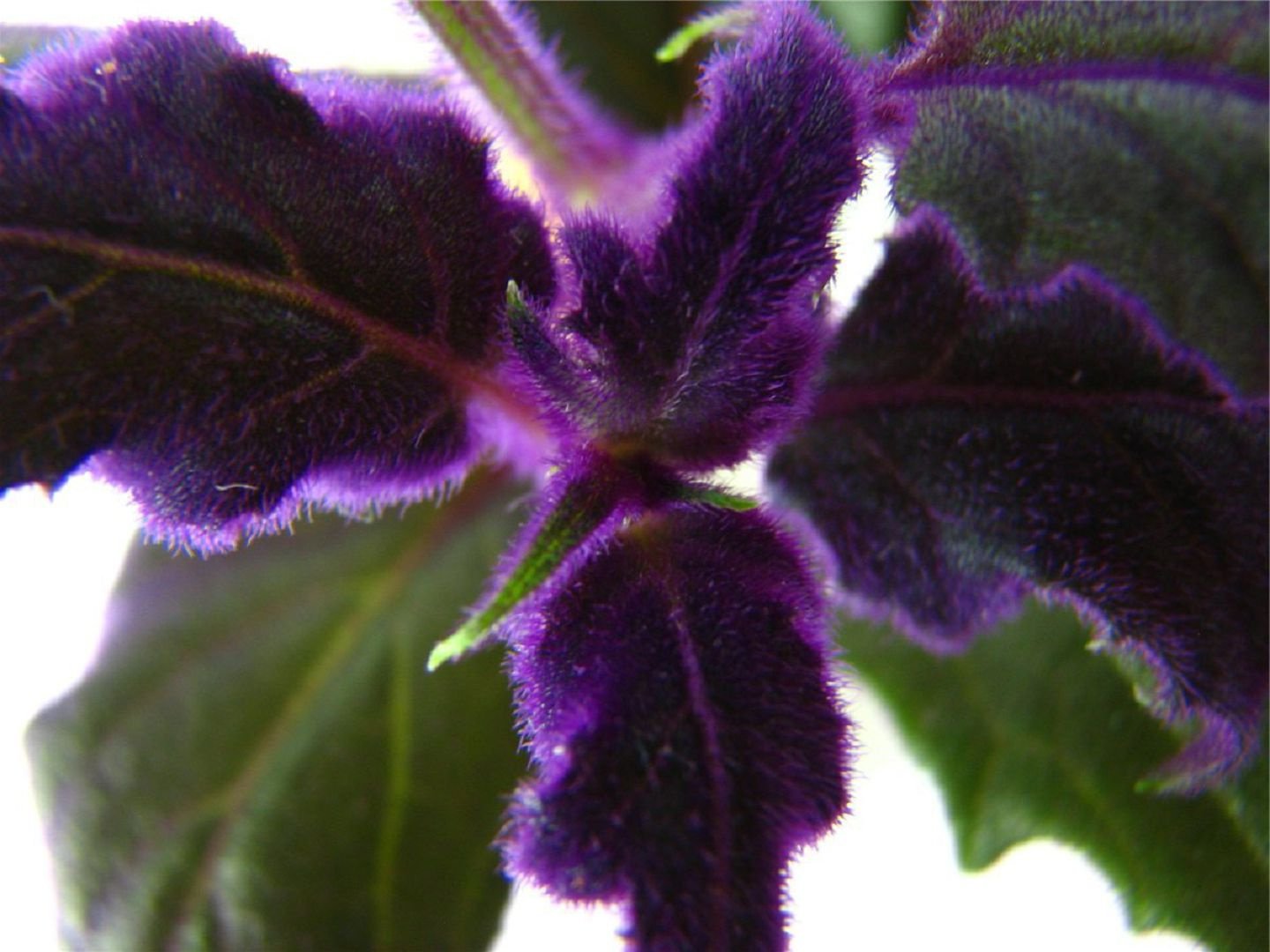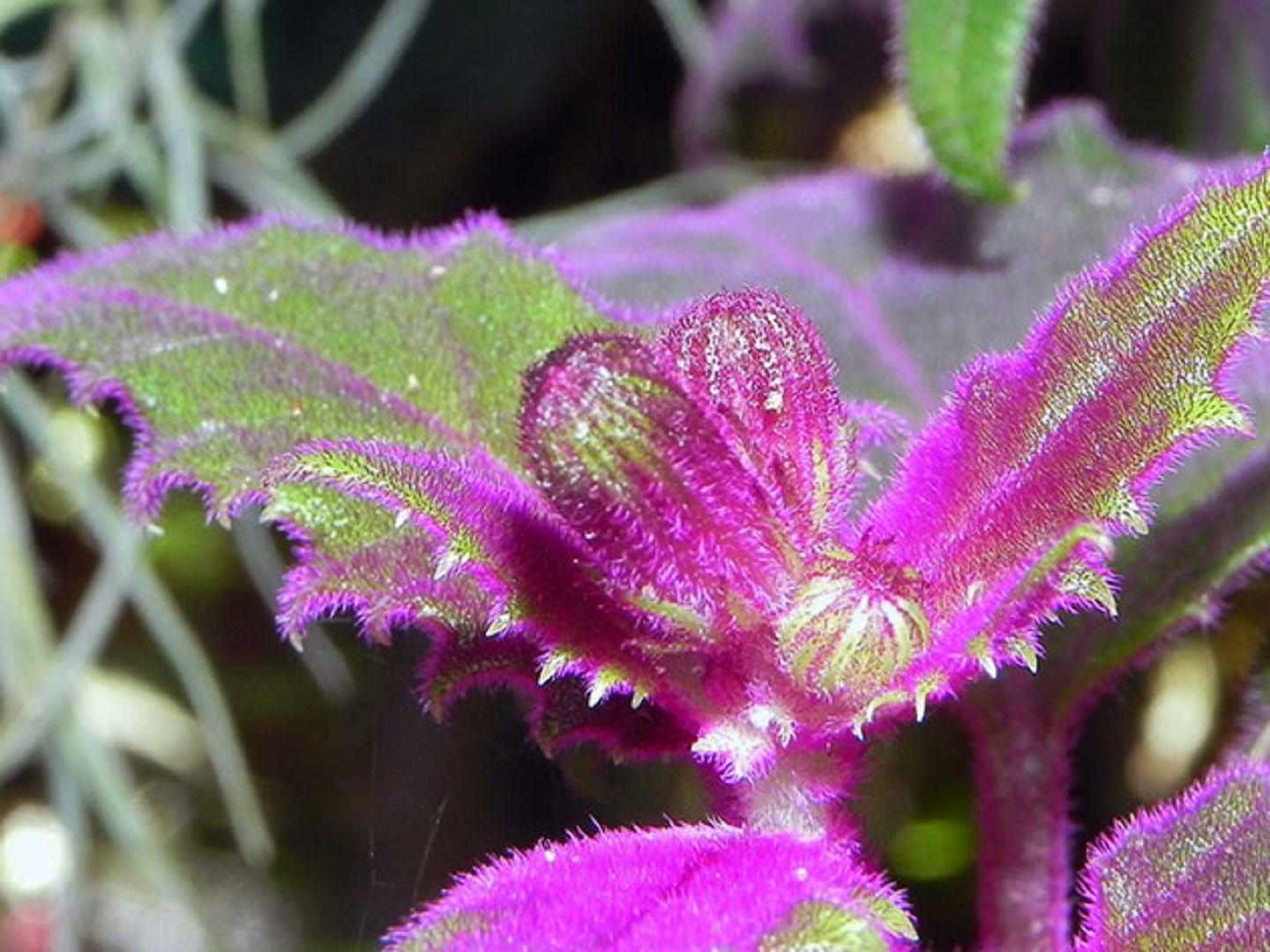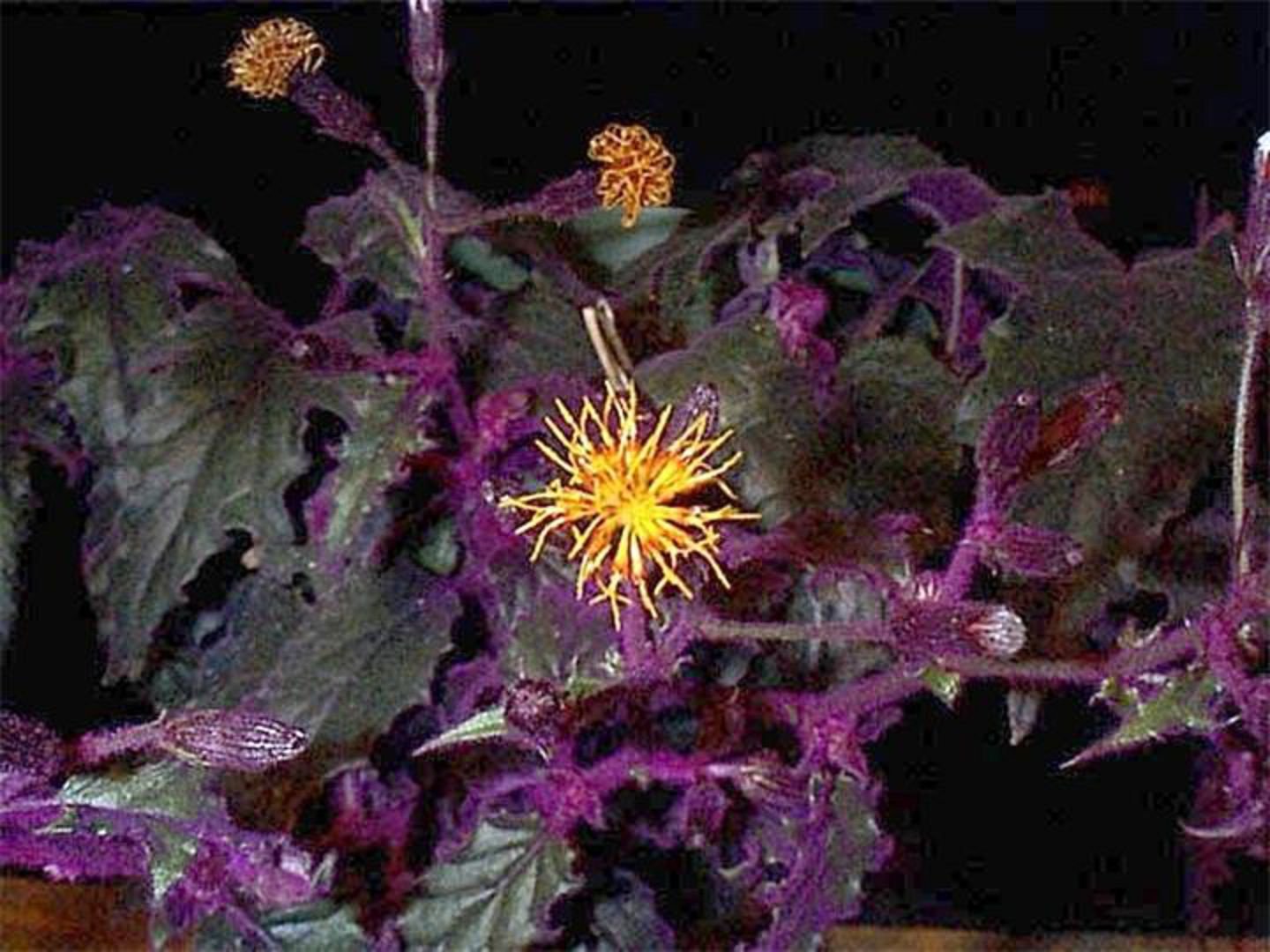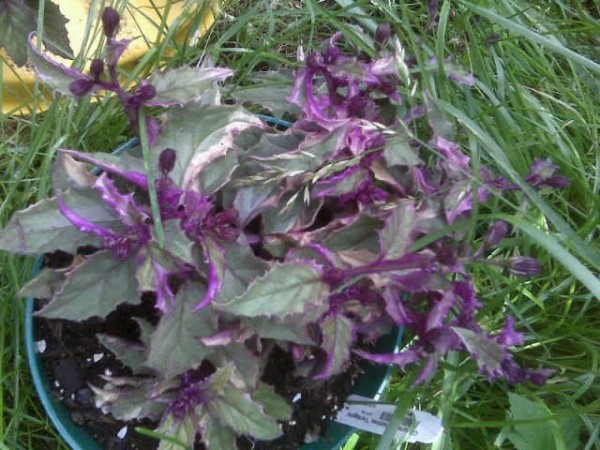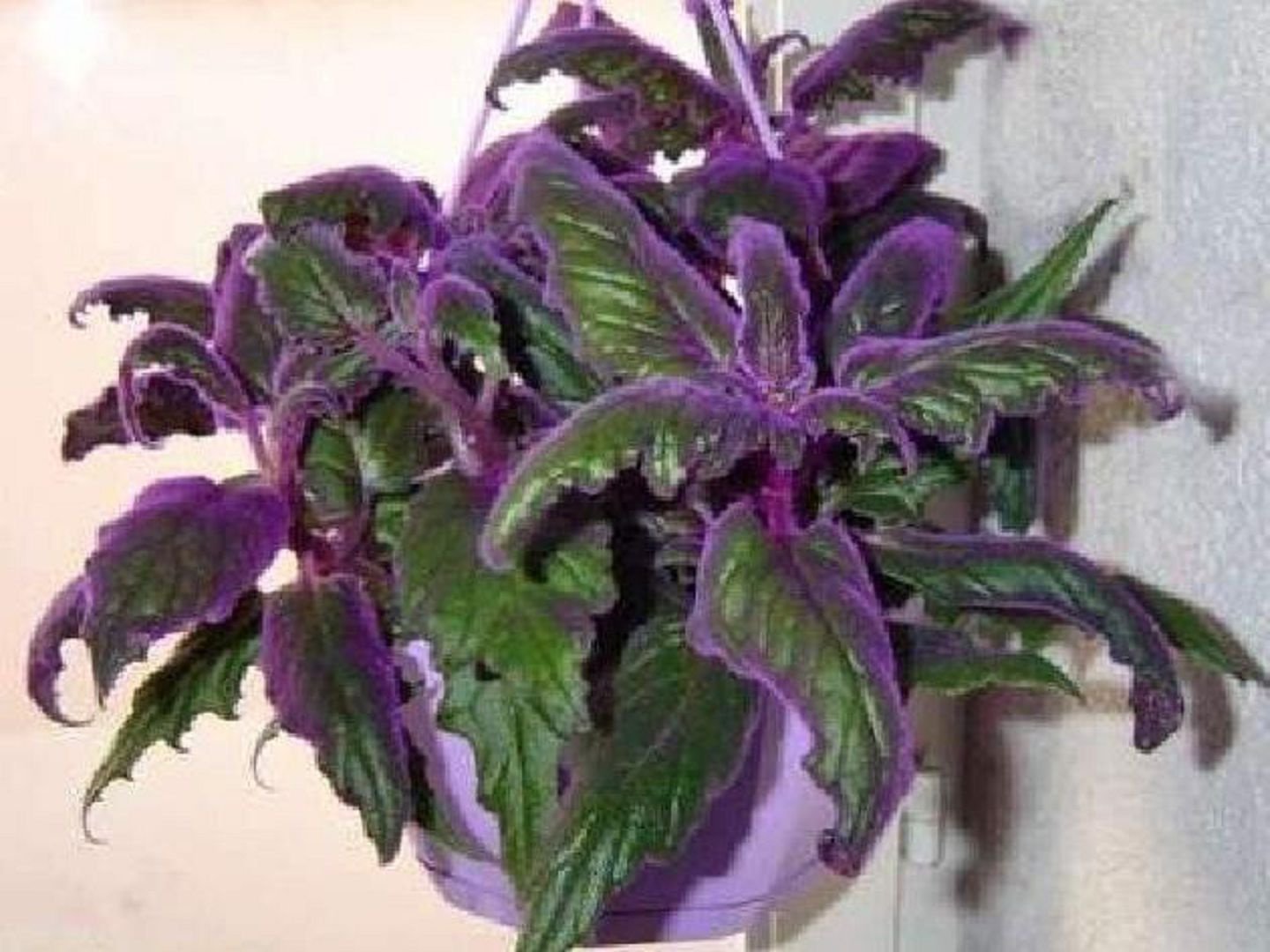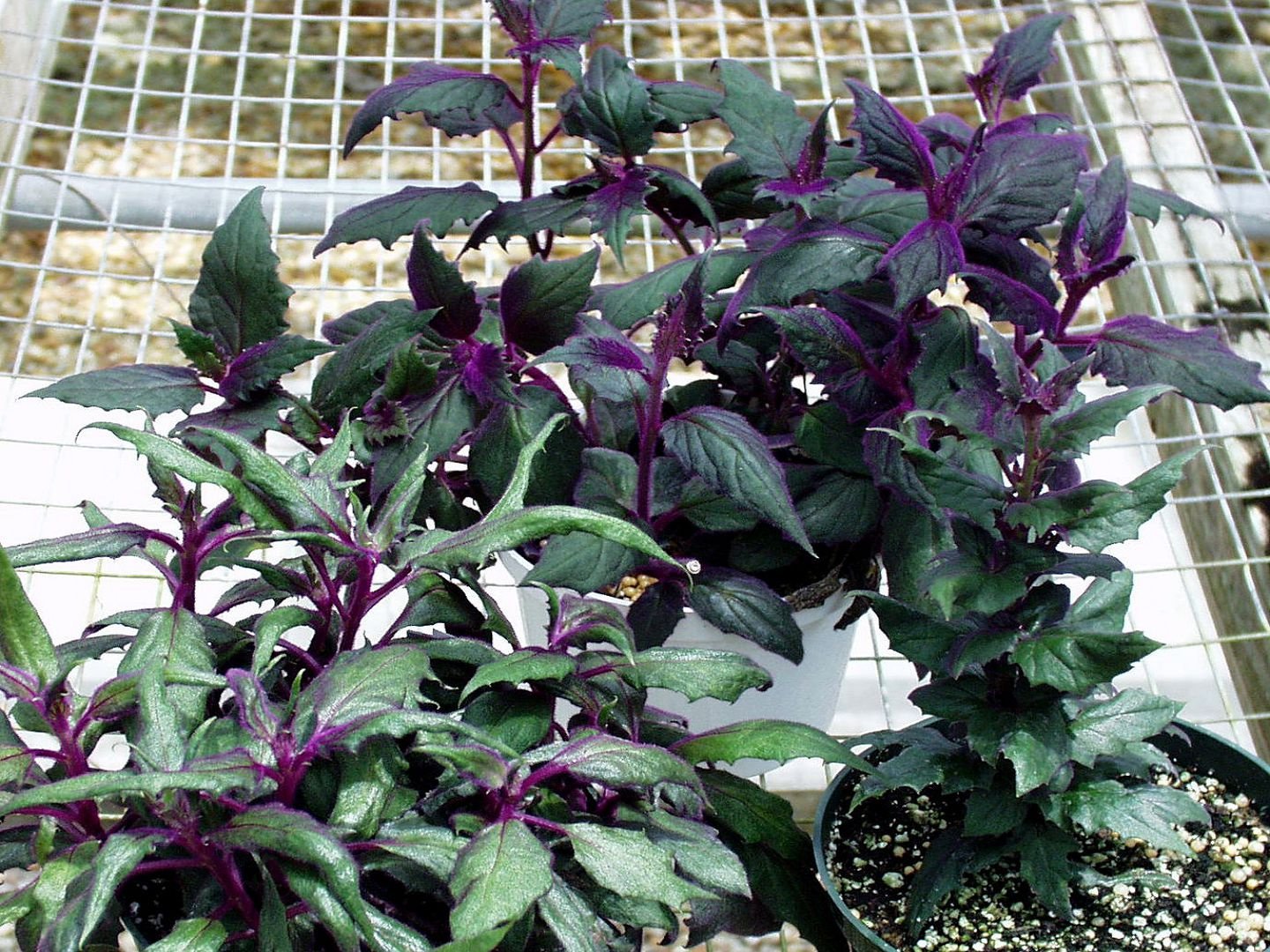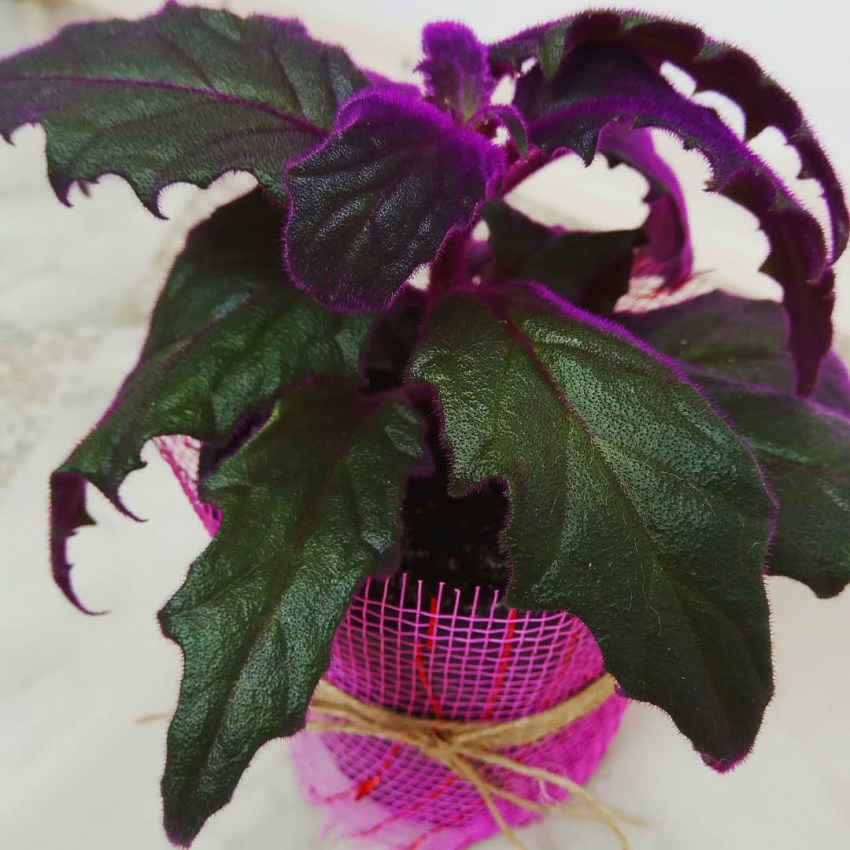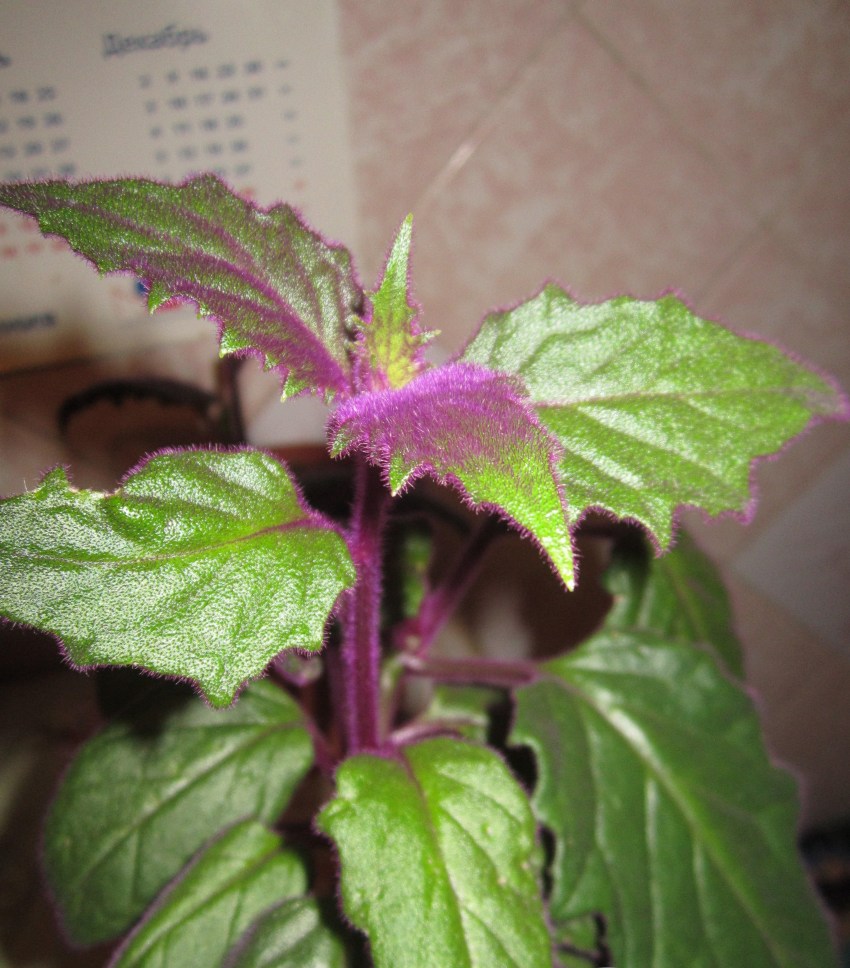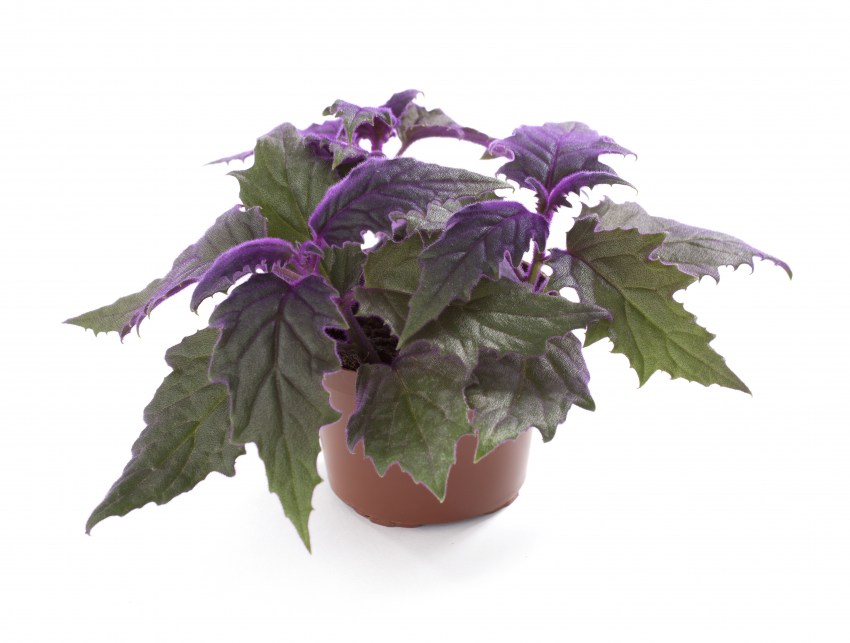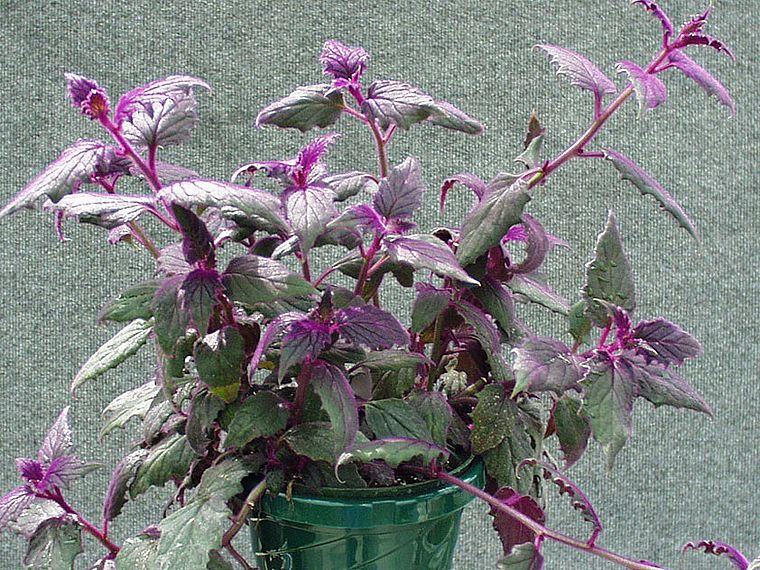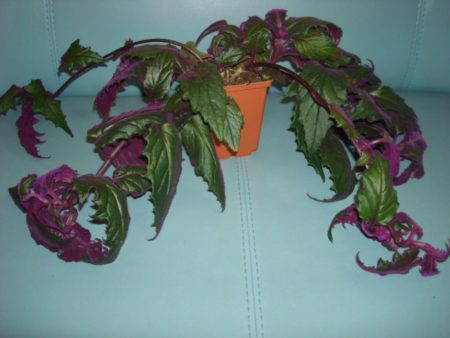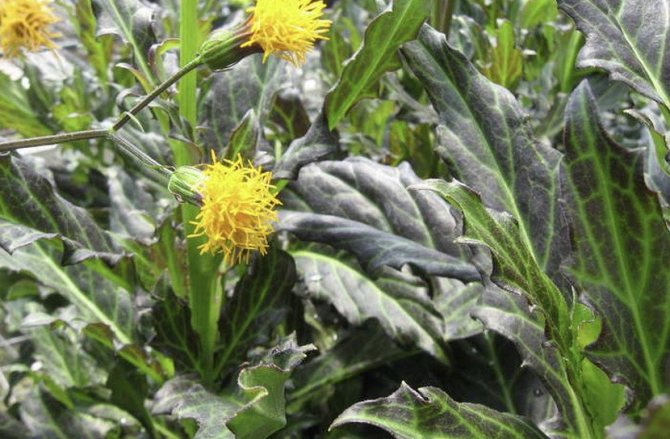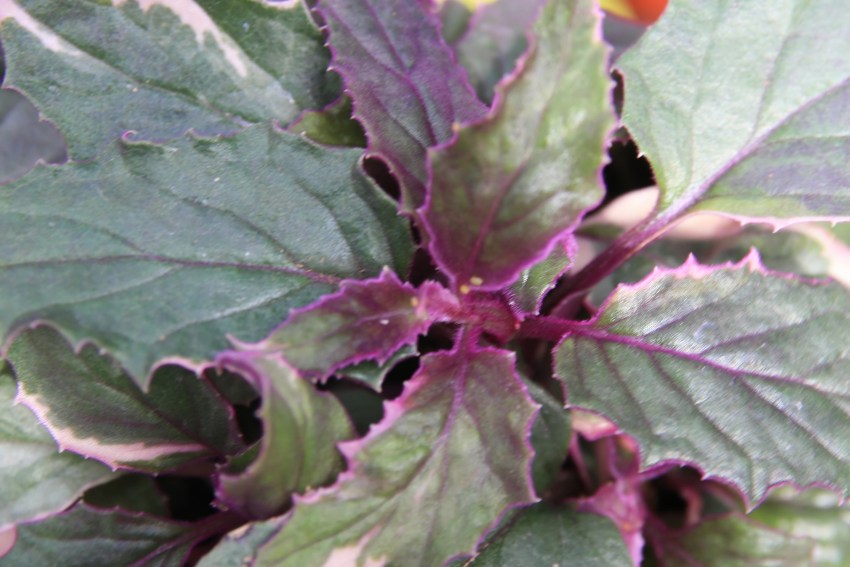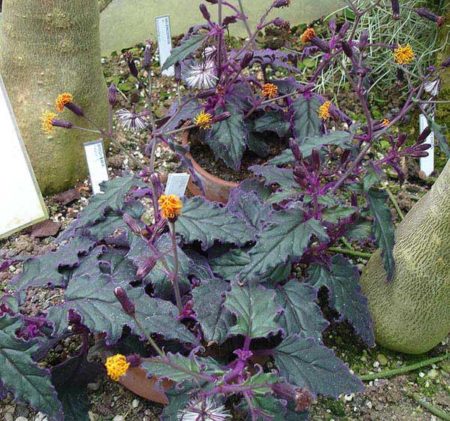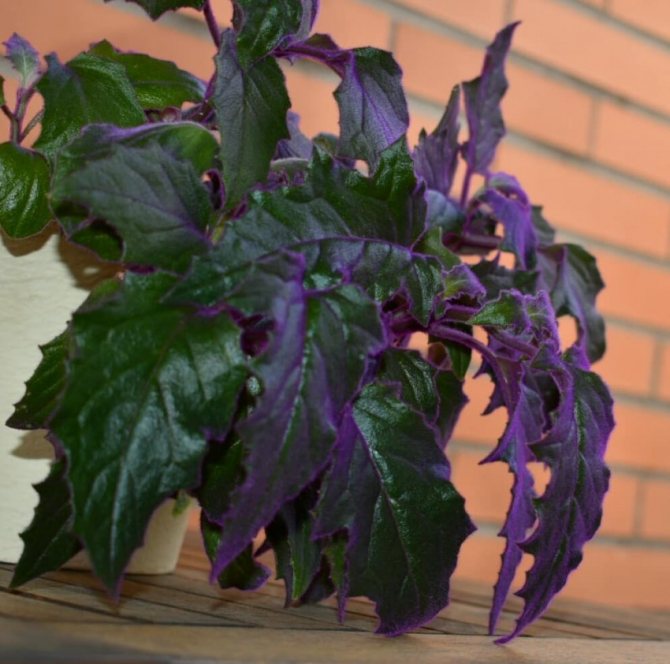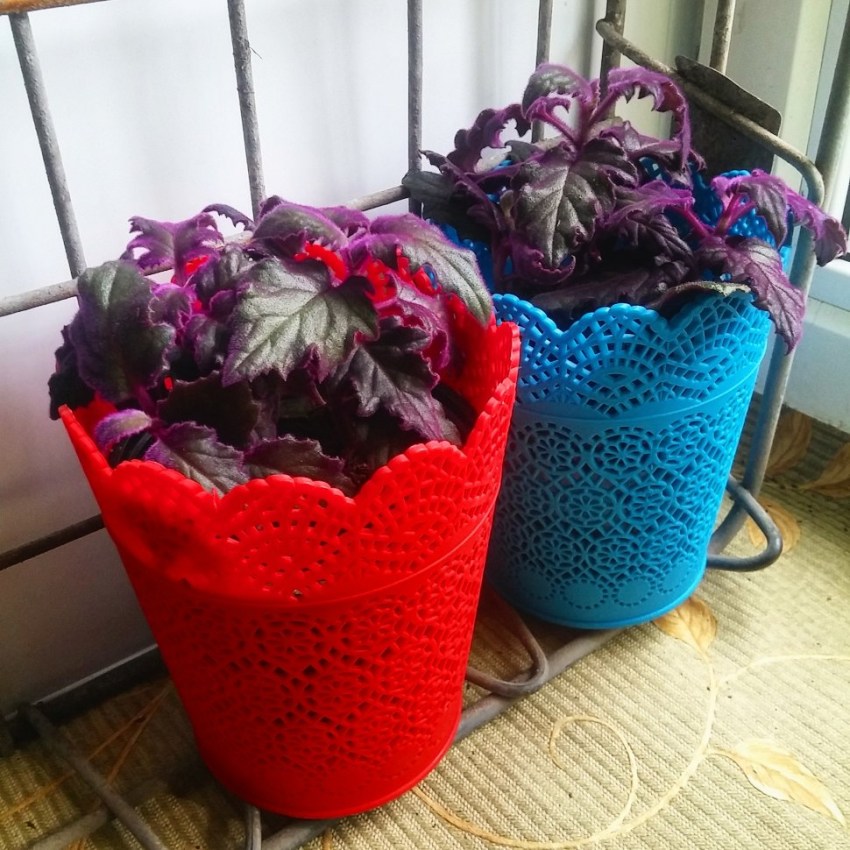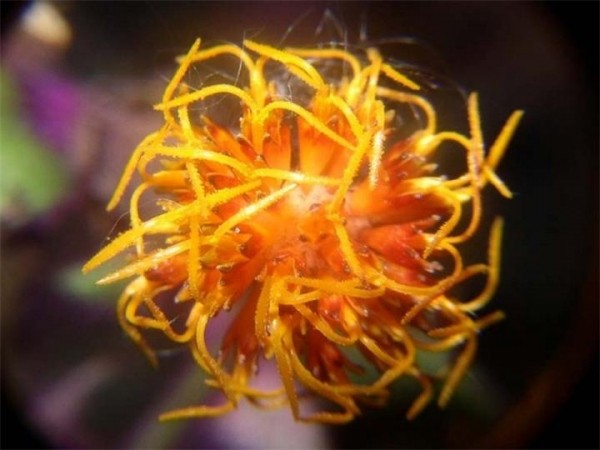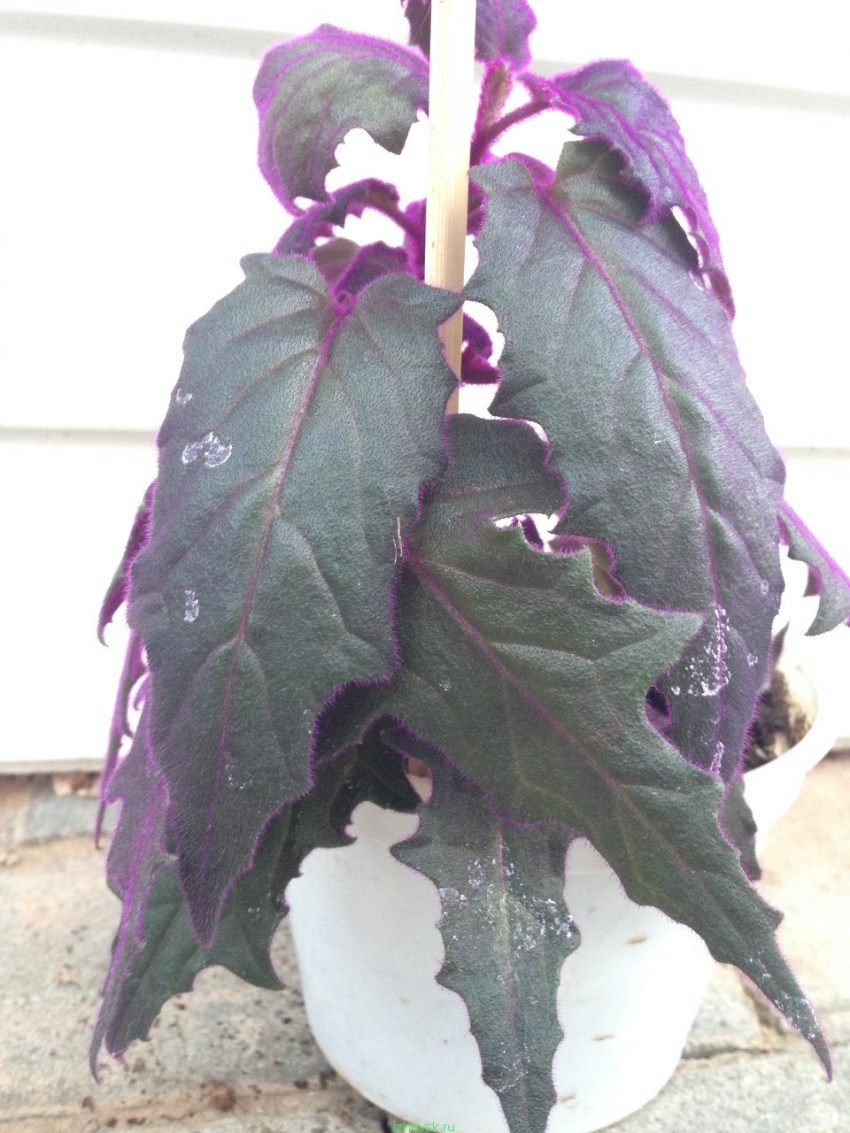Types of room ginura
Scientists are still arguing about how many species of such a flower exist in nature. Some say less than fifty, others more than a hundred. But in any case, only a few “domesticated” species can be seen on our windowsills.
Orange
Purple evergreen bush, grows up to a meter in height. By the way, the leaves and the stem of the flower are actually green, but the thick colored pile disguises the plant so much that it looks purple both from afar and up close.
The species got its name because of the flowers.
“In the wild” such ginura can be found on the island of Java.
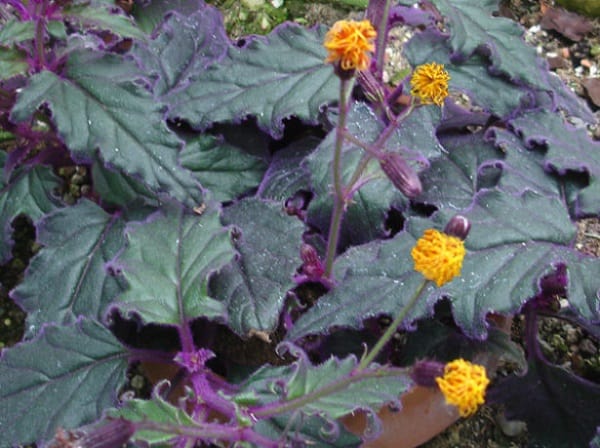
Wicker
This is also a species with green leaves and purple pile.
But the stems of the plant do not stretch up, but down, and they droop beautifully, therefore, such flowerpots are planted not in pots, but in a hanging planter. In height, this bush rarely stretches higher than 60 cm.
The wicker ginura came to us from East Africa.
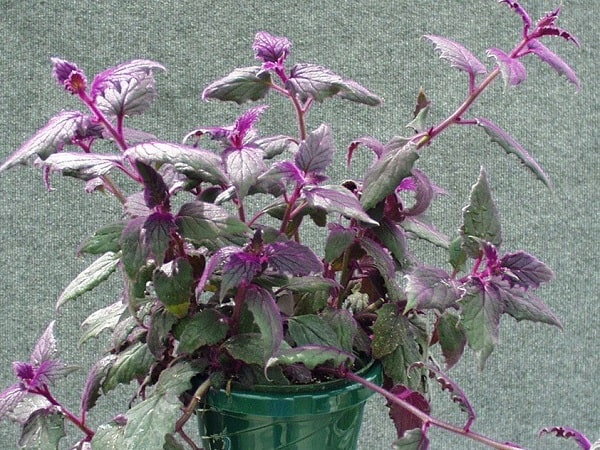
Climbing (climbing)
Such a shrub can be seen more often in a greenhouse than in apartments.
It blooms with the same "dandelions" as the orange ginura, but its leaves are already greener.
If you want to grow it at home, plant it immediately in a hanging box or hanging planter. Long (up to 2 m) shoots will fit well into the decor of your balcony.

Variegated
Modern decorative hybrid.
"Newborn" leaves of the plant are all pale pink, but the older they get, the more they turn green. And not over the entire sheet plate, but in places. It looks very nice. Old leaves do not completely get rid of the pink border.
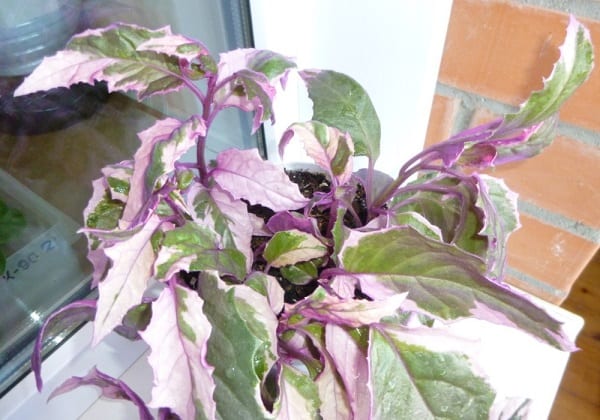
Home care
Ginura does not require special care at home. The plant is unpretentious and light-requiring, but in poor lighting, the leaves will fade. The shrub is best placed on the windowsill from the west or east. The plant must be accustomed to the bright sun gradually.
Crown formation
To form a magnificent and dense crown, it is necessary to pinch the upper part of the stems that are branches. This stimulates the growth of side shoots well.
Landing
A cutting of the future shrub is placed in some water so that Ginura can take root. The soil is prepared from sod and leafy soil, humus, peat and sand in equal proportions. After that, Ginura is planted in a pot.
Transfer
The shrub is transplanted in the springtime as needed. Before transplanting, the plant is well watered. The bottom of the new pot must be drainage.
For transplantation, you can buy a ready-made substrate or prepare a mixture of sand, humus, leaf and sod land in a ratio of 0.5: 1: 1: 1
Carefully removed from the pot, trying not to damage the shoots. Clean the roots from the previous soil, place in a new container and cover with earth
IMPORTANT! After transplanting, Ginura should be placed in a dark place for a couple of days and watering should be limited to adapt the flower. Then return to the windowsill.
Growing
Caring for Ginura at home is not required, but some rules still need to be followed. Although Ginura is a perennial plant, it is not advisable to keep it for more than two years, since the foliage loses its brightness. If you nevertheless decided to leave the plant, then the flower must be often cut off or grafted for propagation.
Reproduction
The shrub is propagated by cuttings and seeds.
In the first case, you just need to break off a twig 10 cm long and put it in water in a temperate and well-lit room. A week later, the first roots will appear, after which they can be transplanted into the ground.
If the flowers of an adult Ginura are not cut off, then seeds can be collected from them. Immediately after harvest, the seeds are sown in a drainage pot filled with substrate or prepared mixture.
PAY ATTENTION to other home-grown plants that can also be propagated in several ways: cuttings, seeds, and others. For example, the graceful and unpretentious "Sheflera", the perennial plant "Ktenante", the flower with beautiful leaves of unusual color "Calathea", the climbing plant "Clerodendrum", as well as the Chinese money tree "Pilea"
For example, the graceful and unpretentious "Sheflera", the perennial plant "Ktenante", the flower with beautiful leaves of unusual color "Calathea", the climbing plant "Clerodendrum", as well as the Chinese money tree "Pilea".
The soil
A ready-made substrate or a mixture of leafy and soddy soil, peat sand and humus is used as the soil. Such soil is used for planting, transplanting and reproduction.
Lighting
The light should be diffused, bright and sufficient. In poor light, the leaves lose their color, and in good light, the color of the foliage intensifies and becomes brighter.
Temperature
The shrub does not tolerate heat. In summer, it is better to keep it at a temperature of 20 - 25 degrees. In winter, the plant needs rest and it is advisable to place it in a cool place at a temperature of 10-15 degrees. In the spring, it is better to put Ginura on the balcony or take it out into the garden.
Humidity
The plant is hygrophilous and should be watered abundantly. Sometimes you can spray the leaves with warm water, and then shake off the droplets from the villi.
REFERENCE! Cleaning the foliage from dust is carried out with a brush.
Care errors, diseases and pests (table)
| Manifestation | Cause | Elimination |
| Ginura leaves lose their purple color and turn green | Lack of light. Excess nitrogen feeding. | Place the plant closer to the sun. Provide backlighting in winter and apply nutrient solution less frequently. When feeding ginura, dilute the fertilizer more than is written in the instructions. |
| The leaves become smaller, turn pale. | There is not enough nutrition. The plant blooms and spends all its energy. | Feed the ginura during the growing season and remove the flower stalks and buds. |
| There are dark spots on the foliage. | Inaccurate watering or spraying of the plant. These stains leave large droplets. | When watering, the water should not get on the leaves. It is not necessary to spray the ginura, humidify the air around. |
| Leaves wither, dry and fall off. | Drying out of the soil. | In the spring and summer, water the ginura abundantly; in the winter, do not allow the soil to completely dry out. |
| Shoots become bare, hang, lose elasticity. | Ginura has grown overgrown. | If there are young twigs at the base, try refreshing pruning and cut and root the cuttings to create new plants. |
| Young leaves and shoots twist and die. | Defeat by aphids. | Due to the fuzzy leaves of ginura, it is more difficult to deal with pests. This plant cannot be washed in the shower. Therefore, at the first sign of infection, immediately apply insecticides. Process with a specialized or a wide range - actellik, fitoverm, admiral, kinmix, decis, inta-vir. |
| The leaves darken, dry, fall off. A whitish spider web is noticeable. | Spider mite attack. | |
| The leaves turn pale and die. Greenish larvae are visible on the underside. | A whitefly has settled on the plant. | |
| The leaves wither, the shoots wither, the soil is wet. | Decay of roots. | Dry the soil, adjust the watering regime. If it does not help, remove the plant from the pot, remove the rotten roots, sprinkle the slices with charcoal and root former, then transplant into a new sterilized substrate. |
Ginur flower - home care, photo of the plant
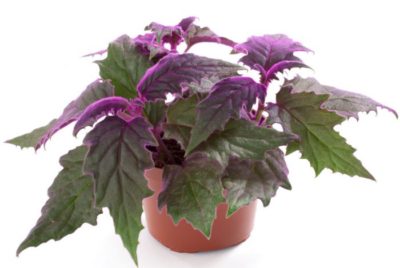 Ginura is an evergreen shrub with delicate velvet leaves. It got its Greek name for its long curly shoots.
Ginura is an evergreen shrub with delicate velvet leaves. It got its Greek name for its long curly shoots.
The plant grows profusely and is usually used in decoration as an ampelous one, decorating the interiors of rooms and balconies.But Ginura grown in wide pots also looks elegant on the windowsill.
The leaves are green with a purple border. The transition of the dark green leaves to the purple shade of the stem and veins looks very impressive. Ginura was dubbed "the blue bird" for the extraordinary color scheme.
Unlike leaves, Ginura's flowers have no decorative value and smell unpleasant, so the peduncles are immediately cut off as they appear. Reproduction occurs by cuttings, which must be planted in slightly moist neutral soils.
Pests and diseases
The plant is quite resistant to diseases, but due to improper or insufficient care, pests can start: scale insects, aphids, mealybugs, whiteflies, spider mites.
The scale insects stick to the leaves of the plant, from which they turn yellow, droop, the ginura stops growing and may die. Miniature white moths, or whiteflies, lay their eggs on the leaves of the plant.
The mealybug sucks the juice out of the foliage. You will find it by the characteristic cotton-like discharge that will remain on the stems and leaves. The growth of ginura will be inhibited.
The spider mite also feeds on plant sap. Small white dots under the leaves, a thin, barely noticeable cobweb will indicate his attack. In addition, ticks are carriers of incurable viral infections.
Aphids are also a sucking insect, a carrier of viruses. Special preparations will help get rid of pests - contact a flower shop for them.
There are not many types of ginur grown in the culture. Most often these are orange ginur, rising and wicker.
How to care for a ginur flower at home (with video)
It is important to comply with the requirements for environmental conditions for caring for a ginura flower at home, which consist in ensuring the following parameters:
- Correct placement.
- Temperature conditions.
- Adequate lighting.
- Watering and feeding.
- Transplant and pruning.
Proper ginura care at home requires a well-lit room with direct sunlight, which ensures the color intensity of the leaves. Otherwise, the plant becomes thinner and stretches, the tips of the shoots turn pale. For active growth, a moderate temperature of 20 ° C is required, without sharp fluctuations. In the heat, it is advisable to shade the flower on the windowsill, and if it is supposed to be moved to the garden, then place it in the shade of tall trees. In winter, when the daylight hours are short, it is advisable to install additional lighting. Protect the ginura from drafts, but at the same time it is necessary to regularly ventilate the room.
The plant is absolutely undemanding to air humidity and can easily do without spraying. It is necessary to water the indoor moisture-loving ginuru flower so that the entire soil is moistened. You can use settled tap water. In summer, water regularly, as soon as the topsoil dries out, in winter, not too often, otherwise excess moisture can lead to decay of the roots. If in winter the plant is near heating devices, then it is advisable to place the flowerpot in a pallet with wet pebbles. When watering, do not allow water to get on the leaves, as this can cause stains.
Fertilizing the plant is just as important as caring for it, so the ginuru flower is fed twice a month in spring and summer, twice a month, with flower fertilizers for ornamental deciduous plants. In autumn and winter - once a month
A young plant is transplanted annually, an adult - once every 3-4 years. The substrate is prepared from leafy and sod land, humus and sand (1: 1: 1: 0.5). For indoor decorative ginura, you can use ready-made universal soil mixtures, the main thing is that the soil is loose and passes water well.
In the second year of life, ginuru must be transplanted, the actions should be as follows:
- Pick up a pot deeper and wider than the previous one.
- Make holes and provide a thick drainage layer.
- Sprinkle the ginura liberally.
- Transfer the plant with a lump of soil by the transfer method.
- Fill the voids with nutritious soil, compact.
For better branching and the formation of an attractive crown, you should regularly pinch the shoots. They begin to do this already when the plant has 4-5 new leaves. You just need to remove the folded leaf, and several lateral shoots will appear in its place. To rejuvenate an adult plant, it should be regularly cut, do it in the spring. To give shape to long curly branches, flower growers fix them with a wire in the form of an arc over a flowerpot or grow ginura in a flowerpot, allowing the shoots to hang freely.
If the leaves turn pale, then there is not enough lighting for the flower: the solution will be to change the location. If the leaves turn yellow, and the stems are stretched, then the plant must be renewed.
Due to insufficient watering, the leaves may become small or fall off, and due to excessive soil moisture, root rot may begin.
Since the leaves of ginura are pubescent, they are rarely affected by pests. However, dry air, proximity to batteries, lack of moisture can lead to the appearance of such parasites:
- Shield.
- Aphid.
- Spider mite.
If any of the listed pests are found, it is necessary to treat the flower with systemic insecticides, for example, Actellik. You need to use the product twice with an interval of 7 - 10 days, following the recommendations on the package. It is better to choose a product in the form of a spray, so as not to damage the leaves.
Watch a detailed video on caring for your ginura if you have any questions.
Propagation by cuttings
Ginura is so easy to grow from a cuttings that other types of breeding are not even considered. Florists most often do not keep the plant "bald" from old age, but cut the cuttings and grow a young specimen. Rooting takes no more than two weeks. Moreover, it is possible to graft ginura almost all year, excluding winter, when it hibernates.

Ginura cuttings root very easily in light soil.
How to propagate by cuttings
- Choose a healthy shoot on an adult plant.
- Cut off the top (8-10 cm). There should be no more than 4 leaves on the handle.
- Remove the bottom pair of leaves, dip the cuttings for half a minute in a phytohormone solution (Kornevin, Epin, Zircon).
- Pour drainage and a light soil mixture - peat and sand into a small container (sterilize everything beforehand).
- Plant the stalk about halfway down. Tamp the soil around well. Emptiness should not remain.
- Water the seedling, cover with a transparent jar or bag to keep it moist.
- Air the cutting daily by removing the cover for 5-10 minutes.
- Maintain soil moisture.
- After a week or two, the cutting will take root and can be transplanted into a larger pot and nutrient soil.
Cut off shoots can give roots in water, and then it is moved into the ground. But such roots do not always take root well. They are too delicate and cannot adapt to the soil. Therefore, ginura has to form new roots, and this slows down the reproduction process.
Ginura was once very popular in indoor floriculture. Purple plush crocodiles hung from cupboards and decorated windows in many apartments. Now this wonderful plant has been forgotten. But it's time to remember him. Ginura is not only velvety purple leaves that fit perfectly into the interior of any home or office. Ginura prostrate is an extremely useful plant that, like herbs, can be grown on a kitchen windowsill. Caring for this plant will not take much time, but it will definitely add positive emotions, and maybe health. Another popular name for ginura is blue bird. This is no coincidence. The glory of the flower is firmly entrenched behind the ginura, which, like the blue bird, brings happiness. Check it out for yourself - put a ginuru at home. Lucky omens usually come true.
Basic care for this African girl
Light. His plant is very fond of - after all, it was "born" in Africa! You can safely put the pot not only on the western, but also on the southern windowsill (but on the latter, nevertheless, shade your fluffy pet a little at noon). In winter, when the sun "works half-heartedly", it is not a sin to highlight the ginura.
Temperature. In winter, the plant rests and practically does not grow. 14 or even 12 degrees is enough for him. In spring and summer, he needs warmth - about 20 degrees (and above).
Air humidity. Here the plant is unpretentious. However, in winter, the radiator can dry out the "resting" ginura. But you cannot spray it! Just put a container of water next to it (or place the pot in a tray with wet pebbles, expanded clay).
Watering. We saw that the top of the ground is dry - carry a watering can and spill the substrate well. But this is in the summer. If in winter your ginura "cools" at the aforementioned 12 degrees, significantly reduce the amount of watering, otherwise the roots will simply not cope with the excess water for them and will begin to rot.
Nutrition. In spring and summer, you can pamper ginura with complex fertilizer for decorative leaves (2 times a month). In autumn, you can no longer give it, and even more so in winter.
Diseases. Most of all, ginura is afraid of only one misfortune - root rot. Therefore, when transplanting to the bottom of the pot, always lay drainage (if you forgot to buy expanded clay, at least break the foam).
Pests. This African exotic is to the taste of many of our insects - spider mites, whiteflies, and scale insects.
Therefore, it is so important to keep ginura in a humid climate in the heat or during the "terror" of radiators (I remind you - no spraying, a tray with expanded clay - our everything).

Pinching, pruning and breeding
So that the ginura does not grow chaotically, the tops of its stems need to be pinched, and the excess branches should be cut off. This is done in the spring.
This will give you a lot of propagation material for ginura, as this plant propagates by cuttings.
The stalk may be small in length - the main thing is that it has from 2 internodes.
Just put the twig in a glass of water. Within 12-15 days, roots will grow on it, and it can be transferred to the ground.
You can see how the pruning of shoots and their rooting in practice is carried out here:
Transfer
It is also held in the spring. Mature ginura should be transferred to a larger pot about once every 2 years. This procedure significantly rejuvenates the plant. The fact is that if the plant grows "stale" in the old soil and pot, its old leaves will lose their beautiful purple color.
What kind of soil is suitable for this plant?
- 0.5 parts of sand
- 1 part deciduous soil,
- 1 part of turf soil,
- 1 part compost (deciduous humus).
Take a small pot so that the ginura grows up (into the shoots), and not down (into the roots).
An example of a successful ginura transplant will be shown in this video:
An experienced "flower grower" will tell more about the cultivation of ginura in this video:
general description
The foliage of the ginura is incredibly beautiful: the green leaves are cut up and covered with purple piles. At the edges, the purple hue is more saturated. It was for the beauty of the foliage that the plant was called "woman". Ginura has very long shoots, which are called "tail".
The leaves are so unusual and beautiful that ginura has become more and more common in the culture.
IMPORTANT! Ginura blooms for a long time. There are many flowers, but they smell unpleasant and are not particularly attractive, so some of them cut them off .. Since the flowers quickly lose their appearance, they must be removed after flowering
Abundant flowering leads to shrinking foliage, which spoils the entire beauty of the plant.
Since the flowers quickly lose their appearance, they must be removed after flowering. Abundant flowering leads to shrinking foliage, which spoils all the beauty of the plant.
You can get acquainted visually with the wicker ginura in the photo below:
Types of ginura
According to scientific organizations, there are almost 50 species in the genus of ginura, but only a few are grown in culture.
Ginura is orange. Lives in tropical forests on about. Java. On an evergreen shrub with ribbed shoots, there are gray-green leaves with lilac pubescence. The ovoid foliage has teeth of various lengths on the sides. Basket-shaped inflorescences consist of small flowers with narrow petals. The flowers are colored golden.
 Ginura orange
Ginura orange
Ginura is braided. The plant is common in East Africa and is distinguished by miniature carved leaves of bright green color. The drooping stems are densely covered with lilac pile. Their length does not exceed 60 cm. Yellow or light orange flowers bloom at the ends of the shoots.
 Ginura wicker
Ginura wicker
Ginura pinnacle. A rare medicinal plant found in southern China. It has long, creeping whips covered with bright green oval leaves. The inflorescences are located on a long erect peduncle, they resemble a red-orange ball of regular shape. For its tonic properties, ginura pinnate is often called "pseudo-ginseng".
 Ginura pinnacle
Ginura pinnacle
Ginura rising. This rare variety takes the form of a dwarf shrub. The alternate petiole leaves have serrated edges and are colored purplish brown. On the surface of the leaf plate, along the veins, bright green stripes are located.
 Ginura rising
Ginura rising
Ginura is variegated. The plant has unusual leaves. Young foliage is completely colored in a light pink shade, but gradually dark green spots appear on it. On the lower leaves, pink stripes remain only at the edges.
 Ginura variegated
Ginura variegated
Reproduction and transplantation
Reproduction of ginura is carried out in a vegetative way. To do this, cut the apical cuttings with 2-3 leaves. You can also use a leaf stalk. Rooting is carried out in warm boiled water. After 7-10 days of keeping in a warm and bright place, the plant has strong roots. It is transplanted into small potting soil for mature plants.
Ginura should be transplanted every 1-3 years in the spring. The pot is chosen not too large, otherwise the flower will actively increase the root mass, and the ground part can get sick and even die. A layer of drainage material is laid out on the bottom of the pot. The soil is selected nutritious and light. It can be composed of the following components:
- sod soil;
- sheet soil;
- leaf humus;
- sand.
After transplanting, the ginura should be transferred to a place with diffused light for several days and watering should be limited. Often the plant grows and stretches, losing its decorative effect. Experienced growers advise to rejuvenate it every 2-3 years.

Formation of ginura around the arch
Long flexible shoots can easily be wrapped around any support. They are not too fragile, so you can do without even special devices for securing branches, but usually they use a spool of strong thread. The support can be of any shape, but the most beautiful is the arched one. The most impressive result is obtained in the garden, but a miniature arch can also be grown on the windowsill.
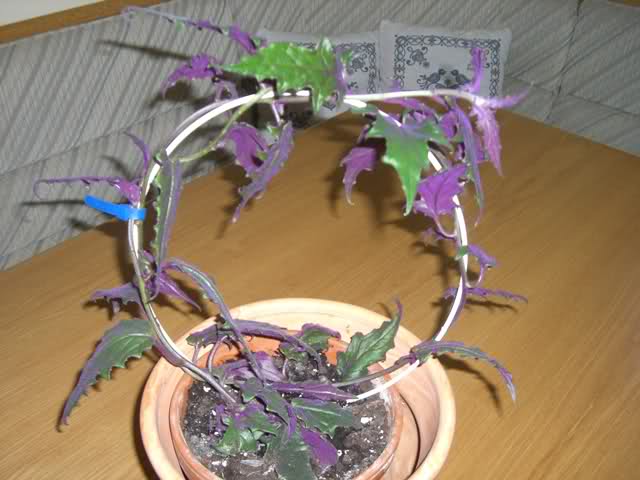
Braiding with shoots of ginura arches
Note! A special device is easy to find in a specialized store, but you can also do it yourself from suitable plastic or wooden rods.
3. Varieties:
3.1. Ginura Wicker - Gynura sarmentosa
Evergreen perennial plants native to Indonesia, which in their natural habitat reach a height of 60 - 90 cm. With age, the stems become woody and covered with bark. The plant has oblong - lanceolate, serrated along the edge, glossy leaves, covered with a network of branched veins. The leaf blades have very attractive purple pubescence. There are variegated variations with pink stripes on the leaves.Peduncles are tall, leafless, bearing 3 to 7 attractive orange flowers, which rarely appear when grown at home.
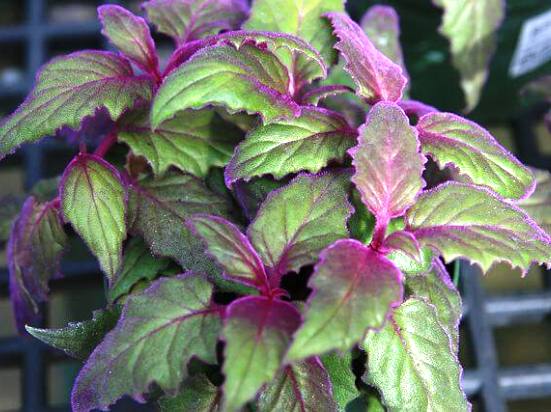
3.2 Gynura procumbens
Evergreen plant from 1 to 3 m high. Stems profusely branched at the base, erect, thick. Leaves are oblong, lanceolate, green, glossy, with branched veins and a finely toothed margin. The leaves are arranged alternately, on short petioles. With age, the stems of plants become woody. During the flowering period, the bushes adorn themselves with small, branched inflorescences bearing orange flowers. Plants are used in traditional medicine because they are believed to lower blood sugar levels, have anti-inflammatory properties, and contain sufficient antioxidants.

Ginura variegated is distinguished by the presence of pink and white spots and stripes of various shapes and sizes on the leaf plates.
You may also be interested in:
Cineraria
Coleus
Syngonium
Calathea
1.Ginura - home care
1.1 Reproduction
Ginura is easily propagated by apical cuttings in early spring. Take 3 - 4 cuttings 8 - 10 cm long and stick the bottom end into a wet mixture of peat and sand. Cover the seedlings with a plastic cap or glass and place in a warm place with moderate light.
Rooting will take only 2 to 3 weeks. After that, remove the glass and start feeding the plants every two weeks.
1.2 How to care
Ginura grows rapidly and reach maturity in one season. This plant is easy enough to grow when given warmth and light. Too long stems are pruned once or twice during the growing season to maintain a compact shape. Peduncles are removed.
1.4 Diseases and pests
Over-feeding makes the stems of the plant thick and soft. Waterlogging, as well as lack of water, affects the quality of the leaves. The leaves turn green and lose their bright purple pubescence when there is a lack of light. Brown spots on the leaves can be caused by water droplets or sunburn. With age, the stem of the plant becomes bare, losing the lower leaves, in this case, replace it with a new one. Ginura stretches when there is a lack of lighting.
1.6 Growing temperature
Normal room temperature is ideal for growing a plant at any time of the year - it does not have a dormant period. The minimum allowable temperature in winter is 13 ° C, but when kept in such coolness, ginura stops growing.
1.7 Watering ginura
Afraid of waterlogging and stagnant water. Let the soil dry between waterings. When the temperature drops below 16 ° C, reduce watering. Try to keep water droplets away from the leaves when watering.
1.8 Transplant
Ginura is changed every 2 years, so a transplant is not always necessary. If, nevertheless, there is such a need, transplant in the spring, while placing several plants in one pot.
1.9 Lighting
The plant must be provided with a brightly lit place. In the shade, it loses its attractiveness. On hot summer days, shade a little, and in winter, provide maximum sunshine.
1.11 Spraying
Will appreciate the humid air. Place the plant pot on a tray filled with damp gravel. Spraying the foliage can leave stains on the leaves, and water trapped in the foliage can cause decay.
Appointment.
Note. After two years, ginura becomes less attractive - replace the plant with a new one obtained from cuttings.
Hydroponics.
Propagation of ginura by cuttings and seeds
Ginura ages quickly at home, so it needs to be renewed about once every 2-3 years. This is due to the fact that only young plants have a rich purple leaf tint. Therefore, the shoots are cut, the strongest cuttings are selected and left for reproduction and rooting.The remaining shoots are pinched, forming a lush bush, and if it has already lost its original decorative effect, it is simply thrown away.
Reproduction of the plant does not cause difficulties - ginur can be propagated by stem cuttings even in a glass of water. It is enough to break off a branch, place it in water or a sand-peat mixture, and after a week the roots will appear on it. Then the cutting should be planted in a small container with nutrient soil. Initially, the pot with the seedling should be placed in partial shade, periodically spray the cutting. When the shoots grow, the ginura can be placed in its permanent habitat.
The second method of reproduction is seed. Ginura usually blooms in spring, but the flowering period may be shifted depending on the light and ambient temperature. The flowers resemble dandelions in appearance, the seeds are also collected on a peduncle and are equipped with an umbrella parachute. The seeds ripen and dry right on the plant, they are sown immediately after collection in a soil mixture from turf, humus and leafy earth, taken in equal amounts, with a small addition of sand. Before sprouting, the soil is regularly moistened with a spray bottle and kept under a film. After the plants emerge, the film is removed, the seedlings are grown and planted in separate pots. Further care is the same as for adult ginur.
Ginura can be grown as an ampel plant in a room or in winter gardens in hanging baskets. Can be used as a climbing flower requiring garters, supports and branch direction.
Some plant species have medicinal properties and are widely used in medicine. So, in China, ginura is actively cultivated, which contains amino acids, trace elements and essential oils. The plant is a raw material for the manufacture of many medicines.
An interesting fact is that in South Asia, the Bicolor (or Okinawan spinach) type of ginura, which is a salad plant, is widespread. It is eaten fresh and used in cooking.
Description
Native to Africa and Asia, this indoor flower belongs to the Aster family. Ginura literally means "girl with a tail." This name was given to the plant in honor of its long and drooping shoots. This is an unpretentious plant that will suit even completely inexperienced gardeners.
In the initial phase of growth, the shoots are erect. But as soon as the flower grows up, they cannot withstand their own weight and wither. An interesting feature of a flower is its ability to acquire a given shape when placed on a support. By tying up the shoots, you can get an arch, rectangle and other geometry elements in appearance.


With the development of the plant, lateral processes develop on it.
They look very organic and attract attention with their decorativeness. The leaves are alternate on small petioles
Depending on the type, they can be triangular or oval. The size of the leaves varies: the lowest ones are large (up to 20 cm in length), those located above are gradually shortened. The color of the leaves is simply amazing, often pubescent. Lilac, purple and gray-gray shoots attract the attention of many gardeners to this plant.
Ginura blooms from December to May, and under ideal conditions it can bloom all year round. Inflorescences are corymbs and bloom either at the ends of the shoots or in the axils of the leaves. The color is very diverse: orange, yellow, greenish, purple. An interesting feature of the flowers of this plant is the repulsive smell of the buds. Flowering drains the plant greatly. Therefore, a ginuru that is usually going to bloom in an apartment is freed from buds. If the plant has bloomed, then boxes with seeds are formed in place of the buds.

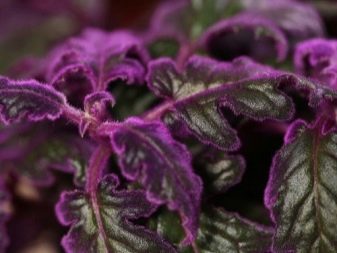
It is important to remember that ginura is a poisonous plant. When working with it, you must wear garden gloves.
In families with children, you need to keep the plant in an inaccessible area, or completely abandon this indoor flower for safety.

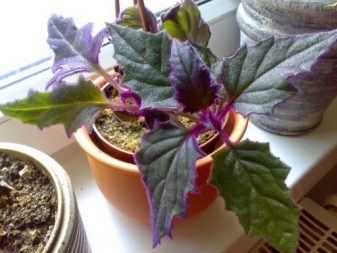
Ginura: home care
In apartments, ginura is not allowed to bloom. Its inflorescences have an extremely unpleasant aroma, so they are left to bloom exclusively in the fresh air. The flowering period is from May to December. If there is enough food, then the process can last all year.
The scutellum inflorescence grows at the tips of the twigs or from the axils of the leaves. Blooms are yellow, purple, orange, green and red. It takes a lot of nutrients from the bush, which leads to the loss of its beauty. Pollinated flowers form capsules filled with long brown seeds.
Important! The flower is poisonous, which should be taken into account when working with it, wearing gloves. You can't put pots with it in children's rooms.
If there is not enough light, then the color becomes pale. Direct sunlight can cause burns. The best window sills for placing pots are western, eastern. On the southern windows, you will have to glue foil on the glass. In winter, additional lighting will be required to preserve the beauty of the shrub.
For your information! The most light-loving are the weaving and climbing varieties.
The ideal temperature is in the range of 20-25 ° C. In the winter months, the plant needs rest, so the temperature is lowered to 12-15 ° C. It does not tolerate drafts, but needs a daily supply of fresh air.
Disease rarely affects ginura. White bloom on the leaves, as well as violent or black spots, are signs of improper care - a violation of the temperature regime, watering. Usually, a shoot free from alarming signs is chosen and rooted, and the diseased plant is removed.
Watering and air humidity
Normal humidity in an apartment of about 50-60% is quite enough for ginure; spraying of foliage is not required. Watering is carried out with boiled water at room temperature. The most abundant watering is needed in the summer, and much more moderate in the rest of the months. They practice moistening the soil through the pallet. If water drops fall on the leaves, they can leave ugly brown spots on them.
Pinching, pruning
Ampel varieties need to tie up shoots. If this is not done, then the plant stops growing and developing. Only with the help of pruning it is possible to obtain a symmetrical beautiful crown, which, in the absence of the necessary design, grows too much and untidy. Pinching the ends of the longest shoots stimulates the formation of lateral shoots. The cut branches can be used for rooting.
Reproduction and transplantation
The easiest way to get a young flower is to root the stalk. It is best cut in the spring or summer, but September is fine too. Take the top of the shoot with several leaves. The stalk is dipped into a glass of water, where many roots are formed after a week. They are planted immediately in a permanent pot.
The land is taken universal for flowering indoor plants. If you prepare the soil mixture yourself, then mix the sod land with the leaf soil in equal proportions, add humus and washed river sand. You should get a loose and breathable mixture. At the bottom of the pots, a drainage layer of coarse pebbles or expanded clay must be placed.
Note! The transplant is carried out when the roots completely fill the entire container, usually after a year. It is enough to transfer a lump of soil with roots into a new pot of slightly larger diameter and fill up the missing soil
The plant is preliminarily watered abundantly to facilitate its removal from the container, and after transplanting it is placed for a couple of days in partial shade, leaving it without watering for successful acclimatization.


